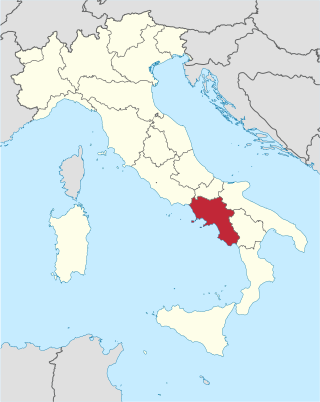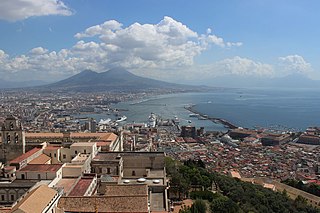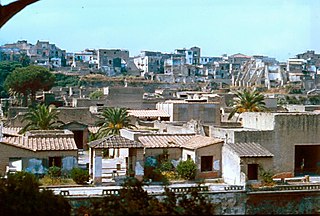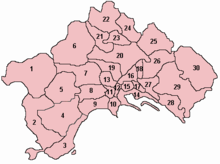
Campania is an administrative region of Italy located in Southern Italy; most of it is in the south-western portion of the Italian Peninsula, but it also includes the small Phlegraean Islands and the island of Capri. The capital of the Campania region is Naples. As of 2018, the region had a population of around 5,820,000 people, making it Italy's third most populous region, and, with an area of 13,590 km2 (5,247 sq mi), its most densely populated region. Based on its GDP, Campania is also the most economically productive region in Southern Italy and the 7th most productive in the whole country. Naples' urban area, which is in Campania, is the eighth most populous in the European Union. The region is home to 10 of the 58 UNESCO sites in Italy, including Pompeii and Herculaneum, the Royal Palace of Caserta, the Amalfi Coast, the Longobardian Church of Santa Sofia in Benevento and the Historic Centre of Naples. In addition, Campania's Mount Vesuvius is part of the UNESCO World Network of Biosphere Reserves. The Region plays also a key international role in international diplomacy, since it is home to NATO's Allied Joint Force Command Naples and of the Parliamentary Assembly of the Mediterranean.

Naples is the regional capital of Campania and the third-largest city of Italy, after Rome and Milan, with a population of 909,048 within the city's administrative limits as of 2022. Its province-level municipality is the third most populous metropolitan city in Italy with a population of 3,115,320 residents, and its metropolitan area stretches beyond the boundaries of the city wall for approximately 30 kilometres. Naples plays also a key international role in international diplomacy, since it is home to NATO's Allied Joint Force Command Naples and of the Parliamentary Assembly of the Mediterranean.

Neapolitan is a Romance language of the Italo-Romance group spoken in Naples and most of continental Southern Italy. It is named after the Kingdom of Naples, which once covered most of the area, and the city of Naples was its capital. On 14 October 2008, a law by the Region of Campania stated that Neapolitan was to be protected.

Pozzuoli is a city and comune (municipality) of the Metropolitan City of Naples, in the Italian region of Campania. It is the main city of the Phlegrean Peninsula.

The province of Naples was a province in the Campania region of Italy.

The history of Naples is long and varied, dating to Greek settlements established in the Naples area in the 2nd millennium BC. During the end of the Greek Dark Ages a larger mainland colony – initially known as Parthenope – developed on the Pizzofalcone hill in the 8th century BC, and was refounded as Neapolis in the 6th century BC: it held an important role in Magna Graecia. The Greek culture of Naples was important to later Roman society. When the city became part of the Roman Republic in the central province of the Empire, it was a major cultural centre.

Ercolano is a town and comune in the Metropolitan City of Naples, Campania of Southern Italy. It lies at the western foot of Mount Vesuvius, on the Bay of Naples, just southeast of the city of Naples. The medieval town of Resina was built on the volcanic material left by the eruption of Vesuvius that destroyed the ancient city of Herculaneum, from which the present name is derived. Ercolano is a resort and the starting point for excursions to the excavations of Herculaneum and for the ascent of Vesuvius by bus. The town also manufactures leather goods, buttons, glass, and Lacryma Christi wine.

The Naples Metro is a rapid transit system serving the city of Naples, Campania, Italy and some parts of the adjacent comuni of its metropolitan area through Line 11. The system comprises three underground rapid transit lines.

Giugliano in Campania, also known simply as Giugliano, is a city and comune (municipality) in the Metropolitan City of Naples, Campania, Italy. A suburb of Naples, as of 2017, it had some 124,000 inhabitants, making it the most populated Italian city that is not a provincial capital.

Bacoli is a comune (municipality) in the Metropolitan City of Naples in the Italian region of Campania, located about 15 kilometres (9.3 mi) west of Naples.

Parco Vergiliano is a public park in Naples, southern Italy. It is located directly across from the Mergellina railway station and in back of the church of Santa Maria di Piedigrotta.

The following outline is provided as an overview of and topical guide to Bulgaria:

The Mergellina Funicular, is one of four operating funiculars in the public transportion system of Naples, Italy. The system is a true funicular: an inclined railway with two passenger cars, connected via cables, operating in concert.
Naples is Italy's fourth largest city in terms of economic size, coming after Milan and Rome and Turin. It is the world's 105th richest city by purchasing power, with a GDP of $69 billion. The economy of Naples and its surrounding area is based largely on tourism, commerce, industry and agriculture. Naples also acts as a busy cargo terminal and the port of Naples is one of the Mediterranean's biggest and most important. The city has had remarkable economic growth since World War II, and unemployment in the wider region has fallen dramatically since 1999. Naples was once a busy industrial city though many factories have shut down in the last decades.

The historic center, or Centro Storico, of Naples, Italy represents the historic nucleus of the city, spanning 27 centuries.

The following is a timeline of the history of the city of Naples. The Naples area has been inhabited since the Neolithic period. The earliest historical sources in the area were left by the Myceneans in the 2nd millennium BC. During its long history, Naples has been captured, destroyed and attacked many times. The city has seen earthquakes, volcanic eruptions, foreign invasions and revolutions.

The Metropolitan City of Naples is a metropolitan city in the Campania region of Italy. Its capital is the city of Naples. The province was established on 1 January 2015 and contains 92 comuni . It was first created by the reform of local authorities and established by Law 56/2014, thus replacing the province of Naples in 2015.
The following is a timeline of the history of the city of Salerno in the Campania region of Italy.

The following outline is provided as an overview of and topical guide to Milan:

The following outline is provided as an overview of and topical guide to Palermo:




















